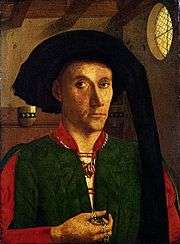Portrait of Baudouin de Lannoy

Portrait of Baudouin de Lannoy is a small oil-on panel portrait by the Early Netherlandish painter Jan van Eyck, completed c. 1435. It shows Baldwin of Lannoy, a contemporary Flemish statesman and ambassador for Philip the Good at the court of Henry V of England.[1] From surviving documents it is known that the work was commissioned to mark his entry into the order Baudouin de Lanno. He is in a formal pose, holding a wooden stick in his right hand, and a gold ring on his little finger. Van Eyck's surviving early portraits typically show the sitter holding an emblem of his profession and class.[2]

The man is dressed in ceremonial robes, with the collar of the Order of the Golden Fleece around his neck. His coat contains dark embroidered motifs in gold, shaped like oak leaves or ferns. The coat contains large strands of red fur lining at the neck and each wrist. His large black felt hat is similar to that worn by Giovanni Arnolfini in van Eyck's Arnolfini Portrait of 1434.[3] Van Eyck has taken a number of liberties with reality to accentuate the features of his model. In particular, the man's head is out of proportion to his body. However, the artist has done nothing to embellish the portrait, presenting the man as he actually looked, with no hit or trace of the idealisation of the early 15th century.[4]
Its first recorded mention is as part of a collection of portrait copies in the Recueil d'Arras.[4] Today it is housed in the Staatliche Museen zu Berlin, Gemaldegalerie, Berlin. X radiograph analysis dates the growth rings in the wood as between 1205 and 1383, and that the wood was taken from the same tree as the board in his Portrait of Giovanni di Nicolao Arnolfini (1438) and the Philadelphia Saint Francis Receiving the Stigmata (c. 1430-32) usually attributed to van Eyck or his workshop.[5]
Notes
Sources
- Borchert, Till-Holger. Van Eyck. London: Taschen, 2008. ISBN 3-8228-5687-8
- Campbell, Lorne. "The Authorship of the Recueil d'Arras". Journal of the Warburg and Courtauld Institutes, Vol. 40, 1977. pp. 301–313
- Ferrari, Simone. Van Eyck: Masters of Art. Munich: Prestel, 2013. ISBN 3-7913-4826-4
- Harbison, Craig. Jan van Eyck: The Play of Realism. London: Reaktion Books, 1991. ISBN 0-948462-18-3
- Klein, Peter. Dendrochronological Analyses of the Two Panels of "Saint Francis Receiving the Stigmata". In Rishel, Joseph: Jan Van Eyck's Two Paintings of Saint Francis: Receiving the Stigmata. PA: Philadelphia Museum of Art, 1997. ISBN 0-8763-3115-0
- Upton, Joel Morgan. Petrus Christus: His Place in Fifteenth-Century Flemish painting. University Park, PA: Pennsylvania State University Press, 1989. ISBN 0-271-00672-2
